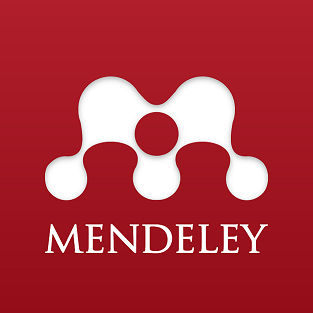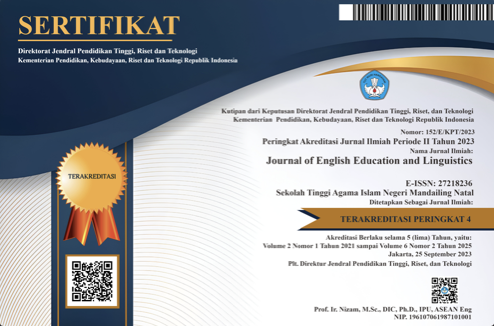AN ANALYSIS OF A 1.6 YEAR OLD BOYS’ LANGUAGE ACQUISITION PROCESS (A CASE STUDY ON BILINGUAL FAMILY)
DOI:
https://doi.org/10.56874/jeel.v1i2.241Keywords:
language acquisition process, syntax, vocabulary, bilingual familyAbstract
In this case, the writer presents how the child (a boy) acquires the language. The natural process of language acquisition takes place since birth. This study will focus on language acquisition process of a 1.6 year old boy who becomes the object of the observation. In a fact, human language skills can be improved through two ways, namely acquisition and learning. The methodology of this research is descriptive qualitative approach. The techniques of collecting data used are documentation and observation. The objectives of descriptive qualitative study are obtained from the utterances of a 1.6 year old boy, his name is Fati. On the discussion part the analysis will focus on syntax, vocabulary and the factors that affect him in acquiring language. As the object, the boy is obtained four languages as simultaneous languages, namely Indonesian, English, Mandailingnese and Javanese. In conclusion, the object of this case is able to produce words and phrases based on he usually heard
References
Bolinger, Dwight. (2002) Aspect of Language. Second Edition. America: Harcourt Brace Jovanovich, Inc.
Carroll, David W. 2008. Psychology of Language: Fifth Edition. USA: Thomson Higher Education.
Dardjowodjojo, S. 2003. Psikolinguistik: Pengantar Pemahaman Bahasa Manusia. Jakarta: Yayasan Obor Indonesia.
Fromkin ,Victoria (1983) An Introduction to Language.Third Edition.New York. CBS College Publishing.
Fromkin, V., Rodman, Rodman, R., and Hyams, N. (2010). Introduction to Linguistics. Philippines: Cengage Learning Asia.
Field, John. 2004. Psycholinguistics: The Key Concepts. London: Routledge.
Gentner, D. & Namy, L.L. 2006. Analogical processes in langugae learning. Journal of Current
directions in psychological science, Vol. 15, No. 6, retrieved on July 2, 2020. Hutahuruk, Bertaria Sohnata, 2015. Children First Language Acquisition At Age 1-3 Years Old In Balata. Retrive: 5 July 2020, from IOSR Journal Of Humanities And Social Science
(IOSR-JHSS) Volume 20, Issue 8, Ver. V (Aug. 2015), PP 51-57
Rangkuti, R. and Muchtar, M. (Ed). 2014. Understanding General Linguistics Book II. Medan.
Slobin, D. Isaac (Ed.). 1985. The Crosslinguistic Study of Language Acquisition. USA, Lawrence Erlbaum Associates, Inc.
Simanjuntak, M. 1987. Pengantar Psikolinguistik Moden. Kuala Lumpur Dewan Bahasa dan Pustaka Kementerian Pelajaran Malaysia.
Schutz, Ricardo. 2014. Stephen Krashni's Theory of Second Language Acquisition. Retrive: 3 July 2020, from NetLibray:http://www.sk.com.br/sk-krash.html.
Tarigan, Henry Guntur. 2008. Berbicara: sebagai Suatu Keterampilan Berbahasa. Bandung: Angkasa.
Varshney, Radhey L. (2003) An Introductory Textbook of Linguistics & Phonetic. India: Student Store.
Vygotsky, L.S. 1978. Mind and Society: The Development of Higher Mental Processes. Cambridge: Harvard University Press.
Downloads
Published
Issue
Section
License
All articles published in the Journal of English Education and Linguistics are licensed under a Creative Commons Attribution-ShareAlike 4.0 International (CC BY-SA) license. This means anyone is free to copy, transform, or redistribute articles for any lawful purpose in any medium, provided they give appropriate attribution to the original author(s) and Journal of English Education and Linguistics, link to the license, indicate if changes were made, and redistribute any derivative work under the same license.
Copyright on articles is retained by the respective author(s) without restrictions. A non-exclusive license is granted to the Journal of English Education and Linguistics to publish the article and identify itself as its original publisher, along with the commercial right to include the article in a hardcopy issue for sale to libraries and individuals.
Although the conditions of the Creative Commons Attribution-ShareAlike 4.0 International (CC BY-SA) license do not apply to authors (as the copyright holder of your article, you have no restrictions on your rights), by submitting to the Journal of English Education and Linguistics, authors recognize the rights of readers and must grant any third party the right to use their articles to the extent provided by the license.

This work is licensed under a Creative Commons Attribution-ShareAlike 4.0 International License.








